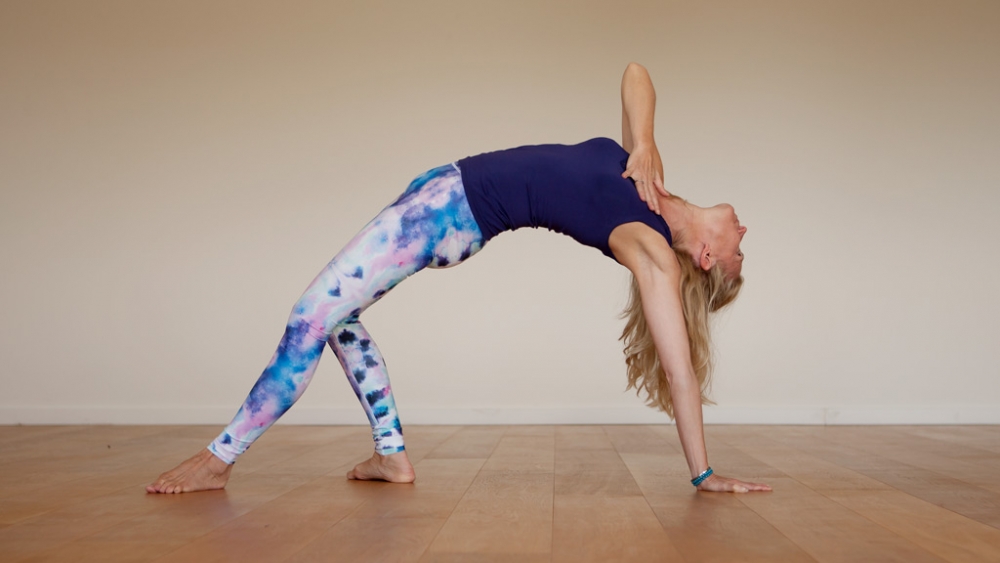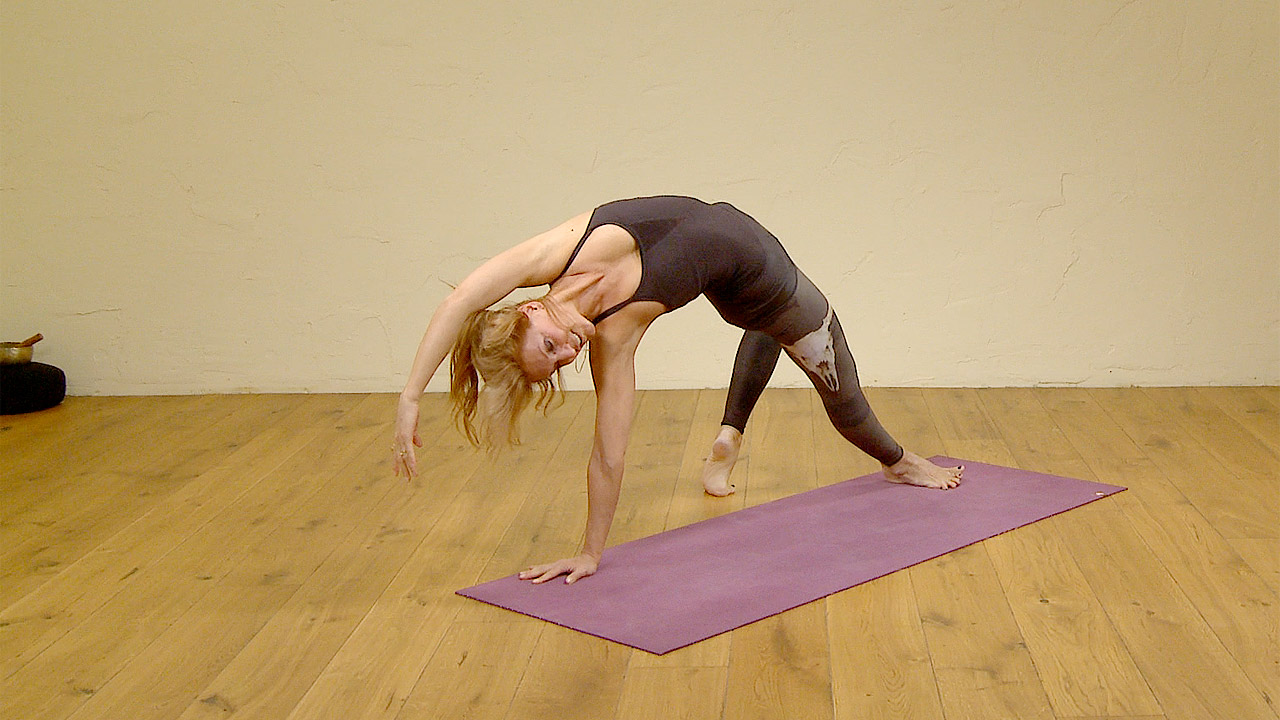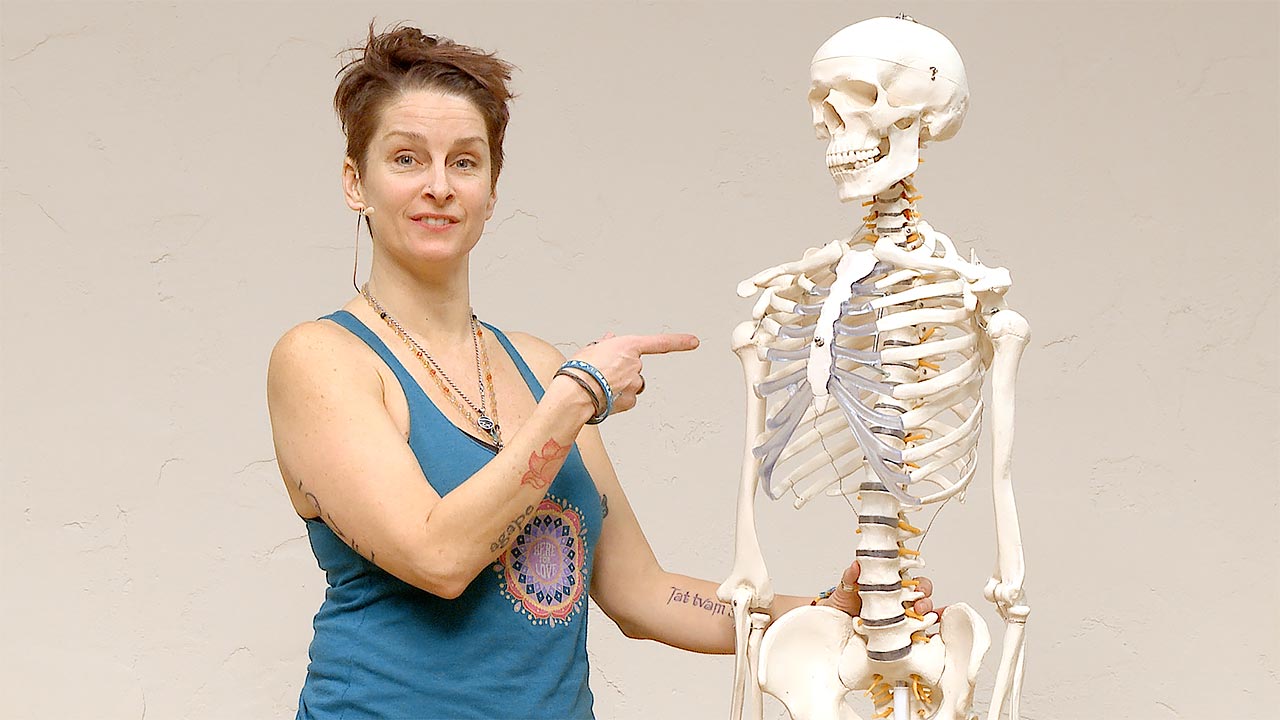Camatkarasana (Wild Thing or ‘Flip Dog’) is a fun, dynamic and challenging yoga posture. It’s a pose that requires strength and suppleness in both the shoulder and hip joints, as well as in the core (front, back and side core muscles of the spine). If done improperly, without the necessary preparatory joint warm-up and muscle activation, and/ or if previous injuries are not appreciated or honoured, Camatkarasana and the transitions in and out of it can cause repetitive motion disorders and/or traumatic injuries.
In this article I recall how I fell in love with practising and teaching the pose and offer a step-by-step sequence to transition into Wild Thing with optimum safety and stability.
My long time love affair with “Flipping my Dog”
The first time I heard a yoga teacher say “flip your dog” was in 2007. Oh, how scared and unprepared I was! I didn’t even flip out of my Downward Facing Dog the first side…I just sort of peeked under my arm in awe of what was happening in the room all around me. And when I did flip out of that second side Downward Facing Dog I had no idea of where I was supposed to place my feet, legs, arms or hands – all I knew was I felt super brave and accomplished! It was such a rush. I felt like exclaiming out loud, “Look at me!!!” To this very day I can still feel the way my wide, expressive, and exhilaratingly HAPPY smile felt on my face.
To this very day I can still feel the way my wide, expressive, and exhilaratingly HAPPY smile felt on my face after my first Wild Thing.
Since then I have loved both practising and teaching “flipping the dog” which is a transition from Three Legged Downward Dog into either a Full Wheel Pose or into what is commonly called Wild Thing (Camatkarasana) an arcing Side Plank variation with a more open chest and shoulder.
The way I teach and practise this transition has changed considerably over the last decade – much slower and with more precision. Due to too many stories from colleagues and students alike about shoulder injuries stemming from improperly practising Chaturanga Dandasana, Side Plank and this transition of “Flipping the Dog”, I have been on a continuous quest to teach anatomy and safe yoga, promoting the importance of strength and stability as well as suppleness, especially in the not-so-stable and oh-so-spacious-and-mobile shoulder joint.
The history of Wild Thing
I am a big fan of honouring time-tested traditions. I feel quite lucky to have been practising and teaching as long as I have been because it has afforded me the great opportunity to study and practise with many of the pioneers of modern-day yoga (those who learned classical styles from the likes of BKS Iyengar, Pattabhi Jois, and other students of Krishnamacharya, for instance). John Friend’s Anusara Yoga was a yoga system many of my friends were studying back in the early 2000’s – it is a style that celebrates, among many things, expansive heart opening postures that radiate “Radical Joy”. Wild Thing is one of those postures!
I remember witnessing the practices of my Anusara trained friends and thinking, “WOW…Holy Back Bends!” Their dedication and mastery of the concepts of spiralling open along fascial lines, of using “organic energy” to expand and “muscular energy” to contract paved the way for many of us teaching these creative explorations of Sthira and Sukha (Strength/Steadiness and Comfort/Sweetness) today. Wild Thing requires both of these: stability in the shoulder girdle, bottom hip and spine (muscular energy hugging in) and suppleness in the spine, chest and front hips (organic energy expanding and radiating out).
Shoulder Integration
It is so important to stabilize your shoulder whenever there is weight bearing on the spacious, shallow shoulder joint*. Wild Thing, as well as postures such as Downward Facing Dog, Chaturanga Dandasana, Side Plank, Peacock Feather Pose, Crow Pose and Handstand can impose painful and unnecessary wear and tear to the connective tissues in the shoulder joint if the joint is not strong, supple and stable. Conscious, methodic and continuous integration of the humerus bone into the shallow joint socket is an important key to injury-free success.
Tilting your arc
Over the past year I have been playing with the notion of creating expressive arcs in the body and then slowly – very slowly – turning or tilting these beautiful arcs. Graceful ways to try this are in Dancers Pose, Upward Facing Bow, Lizard variations where you lift and turn to take hold of the back foot, and in the transition from One Legged Downward Facing Dog into Wild Thing. An intelligently sequenced practice, intimate awareness of breath and the sacredness of presence is key to tilting and turning gracefully and safely in these postures.
Step-By-Step process for a safe Wild Thing
1. Warm up
After you centre your body and mind on your breath, begin to warm-up the chest, shoulders, upper back and spine in both seated and tabletop postures.
2. Get your shoulders stable
In seated, table top and Downward Facing Dog postures, wake-up and activate your Perfect Chaturanga muscles (lower trapezius, serratus anterior, infraspinatus and latissimus dorsi) for shoulder joint stability for later Side Plank variations.
3. Strengthen the back, release the front
Strengthen the muscles of the back body (erector spinae, back extensors, posterior deltoids and triceps) and stretch out the front body (rectus abdomonis, pectorals, anterior deltoids and biceps) with low centre of gravity postures such as Sphinx, Cobra, Locust, Half Bow (Danurasana) and Bow.
4. All over strength and heat
Sun Salutations will continue to stretch and strengthen the spine, the entire front and back bodies, shoulder and hip girdles (psoas, gluteus maximus, gluteus medius, deep external rotators, hamstrings and quadriceps).
5. Practise the actions in Side Plank
Side Planks (from easy variations to increasingly more challenging) will further prepare the shoulder girdle and side body for Wild Thing. Make sure to integrate the humerus bone in the socket and shift your heels back in Plank before transitioning into Side Plank. (Read these tips for Side Plank.) Continue to scoop the lower shoulder blade under the ribcage (serratus anterior) for support in Side Plank variations and allow for any chest opening variations to come from the top shoulder blade, arm and chest area. Essentially there’s no movement from the bottom shoulder joint which is quite stable in its foundation.
6. Get into your arc
Add in Scorpion Tail variations of Downward Facing Dog (with a bent raised leg and open hip) to continue to free your obliques, psoas and quadriceps of tightness and tension. Then transition to standing hip openers such as Warrior 2, Side Angle Pose, Half Moon Pose, Bound Half Moon (Sugarcane) and Dancers Pose.
7. Start low – Side Plank to Wild Thing
Make sure to practise at least one Wild Thing from Side Plank (on both sides) before tilting slowly from your Scorpion One-Legged Downward Facing Dog to Wild Thing. I suggest a 5-count transition before your toes touch down in Wild Thing. Remember – the bottom shoulder joint is the foundation. It’s the top shoulder that does most of the opening, expanding and expressing!
8. Feel the joy!
Once you safely transition into Wild Thing, pause, breathe and feel the freedom and possibly the ‘Radical Joy’ intended by the original practitioners of this beautiful posture!
9. Transition back with the same care
To safely tilt your arc back from Wild Thing to your Scorpion Tail Downward Facing Dog, exhale all breath out, hug your muscles to your bones and draw your navel towards your spine, push through the bottom hand as you tilt your arc from the floor back into the air.
Always remember…
Honour and respect your body’s limitations, as well as celebrate its possibilities and potential. Sometimes certain poses are not beneficial and can possibly can be injurious if past injuries, traumas and limitations are not recognized, honoured and respected.
Practise in class
EkhartYogis – take a walk on the wild side in Marlene Henny’s Vinyasa Krama class:
‘Let’s get a bit wild for Wild Thing‘ – Vinyasa Flow, 15 mins
Anatomical insight into the shoulder
In this short talk, Jennilee shows us the importance of integrating the upper arm bone into the socket to avoid injury when doing weight-bearing poses such as Chaturanga Dandasana in our yoga practice.



